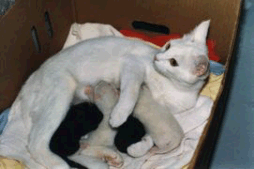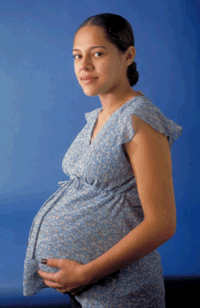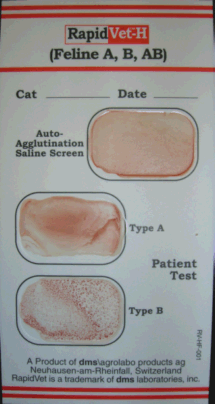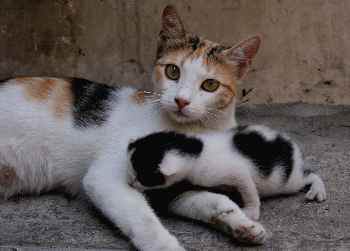|
NEONATAL ISOERYTHROLYSIS IN KITTENS


(Photo Credit: Julian Ortega via Wikimedia Commons)
IMAGINE THIS TRAGIC SCENARIO:
A mother cat in a cattery carries her litter normally and gives birth to a healthy litter of kittens. She cleans them, nurses them, cares for them but within a few days they have all weakened and died. This may happen litter after litter with the cattery breeder wondering what keeps going wrong. While there are many reasons why newborn kittens might not survive, in this hypothetical the kitten loss is predictable and preventable. We are describing "Neonatal Isoerythrolysis."
Neonatal isoerythrolysis is a tragedy among breeders of kittens and is often written off as infectious disease, genetic defects, or simply natural selection. In fact, it is simply a matter of mismatched blood typing.
|
HUMAN EXAMPLE: RH DISEASE
Many of us know our blood type: it is either A, B, O, or AB and comes with a negative or positive after it. It is the negative or positive that comes to be very important when it comes to HUMAN isoerythrolysis. The negative or positive in one’s blood type refers to whether one is negative or positive for a red blood cell protein called “Rh” factor, named for the Rhesus monkeys used in initial studies of this disease.
Problems do not occur when both parents are Rh positive or when both parents are Rh negative or even when the father is Rh negative and the mother is Rh positive. Problems occur with a very special combination.
|

Rhesus monkey - a
common research subject
(Photo Credit: russavia
via Wikimedia Commons)
|
|

(Photocredit: www.usda.gov)
|
When a man who is positive for Rh factor fathers a child with a woman who is negative for Rh factor, the child will be Rh positive. When the mother gives birth, her immune system becomes exposed to the baby’s blood. Her immune system mounts a response against Rh factor and soon she is armed with anti-Rh factor antibodies. This is not a problem for the first born child. It is the second child who is in danger.
When the mother is pregnant again with another Rh positive child, the antibodies of her bloodstream cross the placenta and destroy her unborn child’s developing red blood cells. The unborn child will likely die. Luckily, this condition is preventable by first being aware of one’s Rh status when one becomes pregnant and by the administration of a product called RhIg when the first child is born. RhIg is an anti-Rh factor antibody that destroys any Rh factor entering the mother’s body at the time of the first birth. The Rh factor is destroyed before the mother’s immune system “sees it” thus preventing her from producing the antibodies that would attack her second child’s blood.
For more information on human Rh disease click here.
|
|
THE FELINE DISEASE
Cats do not have Rh factor but a similar parental blood mismatch can occur involving the feline blood types A, B, and AB blood. Cats with type A blood naturally carry antibodies against type B blood and cats with type B blood naturally have antibodies against type A blood. These antibodies do not need exposure to another cat's blood during birth (as with human Rh disease) or from an incompatible transfusion; those antibodies are just naturally there, ready to attack the opposite blood type.
It turns out that only some type A cats carry anti-B antibodies and the the ones that do only carry small amounts. On the other hand, all type B cats carry a lot of anti-A antibodies. When a type B mother cat is carrying a litter of type A kittens, the stage is set for disaster. In people, antibodies cross the placenta and cause damage to the unborn baby. In cats, the placenta blocks the antibodies and protects the litter but there no natural protection once they are born and have to nurse their type B mother's milk. More specifically, the problem happens when they nurse their mother's colostrum, which is naturally loaded with antibodies aimed at destroying Type A red blood cells.
The feline A,B,AB system is not comparable to the human A,B,O blood typing system. In people, inheriting a Type A gene and a Type B gene creates Type AB blood. In the cat, the Type A is dominant to all other blood types. Any Type A genes will create a Type A cat. This means that when a Type A cat is bred to a Type B cat, each kitten has at least a 50% chance of being Type A.
|

Feline Blood Typing Test
(results are positive for type B blood)
(original graphic by marvistavet.com)
|
WHAT IS COLOSTRUM?
|
Colostrum is special milk produced by the mother of any mammal species for the first 12-24 hours or so. The first day of life is extra special for baby mammals as this is the time when the mother gives a copy of her own immunity to her young. The milk produced in this period is rich with all the antibodies the mother has to give: vaccination generated antibodies, antibodies from exposure to all sorts of proteins she has experienced or infections she has survived, and, of course, antibodies against the “wrong” blood type.
The infant’s intestine is in a sensitive time during this period. The antibodies delivered in the mother’s colostrum are not digested like regular proteins; instead, they are absorbed intact and provide the basis for the baby’s protection against infectious disease until the baby’s immune system is mature enough to make its own antibodies. After the first day of life, the intestine achieves what is called “closure” and no more such absorption takes place. After closure, any proteins that enter the GI tract are broken down as nutrients.
|
 (Photocredit: Morguefile.com) (Photocredit: Morguefile.com) |
The Type B mother cat is giving a great big dose of anti-A antibodies right into her Type A kittens with her colostrum and the babies are absorbing it into their bodies. The antibodies destroy the kittens’ developing red blood cells, they get pale, perhaps even jaundiced. They get weaker and weaker and then they die, poisoned by their own mother’s milk.
PREVENTION AND SAVING THE LITTER
As with human Rh disease, the first step in prevention is awareness. If one is going to breed purebred cats, have their blood types tested before they are bred. This can be done at the vet’s office with a test kit and can often be done “while you wait.” Ideally, a type B mother cat would only be bred to a type B tomcat.
Type B feline blood is somewhat unusual in the mixed breed "domestic short hair" population but it is fairly common in purebred cats, particularly the Asian breeds.
Type A is genetically dominant to type B so that the mating of a type B mother to a type A father will produce at least a 50% chance of type A kittens.
So what do we do about the kittens already on the way? The key to survival is to keep the kittens from drinking their mother’s colostrum. As soon as they are born, they must be removed from the mother cat and either nursed by another mother cat or bottle-fed (see our page on Orphan Kitten Care for full instructions). They can be returned to their real mother after her colostrum production is over. This ought to be 12-18 hours but keep them away for a full day just to be sure. Regular mother’s milk produced after this time is not a hazard as the antibodies will be digested by the babies. During that first 24 hour period, the kittens may nurse on a Type A mother cat or can be bottled or tube fed.
As for the immunity lost by giving up colostrum, there is a next best thing: a plasma transfusion. Feline plasma of the correct blood type can be given to the kittens by injection. (Kittens can be blood typed using cord or placenta blood if one wishes to avoid a needle stick in such a tiny patient). This blood product will contain many protective antibodies and none of the harmful ones. It is not as good as type matched colostrum, but is fairly available in most animal blood banks.
Sick kittens may survive if they are given blood transfusions but the problem is knowing which blood type to use. The kittens want type A blood but if their mother's antibodies are still present, this will not work. The proper treatment is going to depend on how old the kittens are at the time of diagnosis. If they are less than 3 days of age, a transfusion of their mother's type B red blood cells may be the best choice even though the kittens are type A.
BLOOD TYPING
Feline blood typing can be performed by most animal hospitals. If a litter of kittens is planned, see your veterinarian about at least typing the mother cat so that one can plan ahead for complications. Neonatal Isoerythrolysis is a preventable syndrome but only if it is anticipated.

Page last updated: 7/1/2025
|